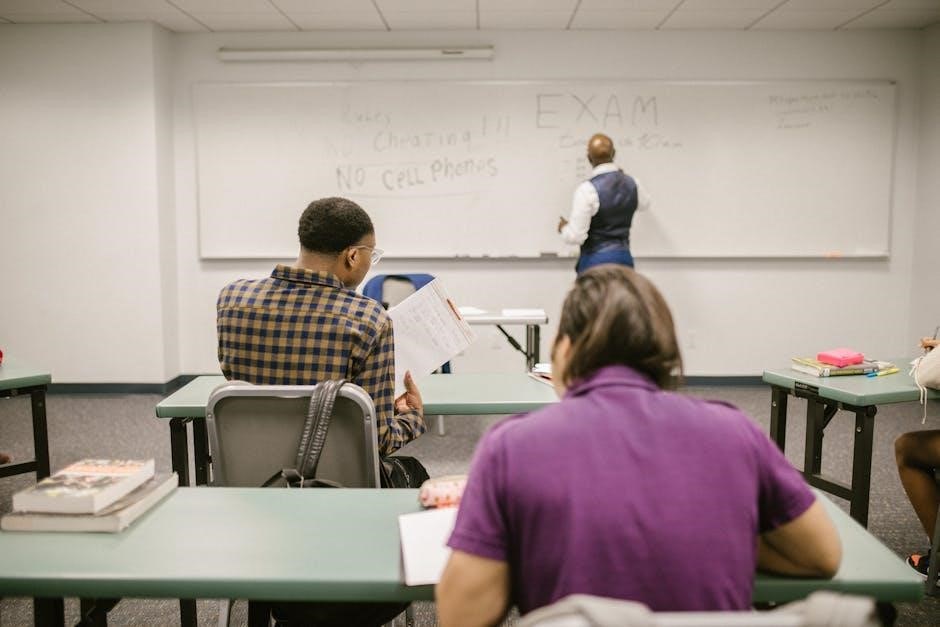Acey-Deucey Backgammon is a popular and exciting variation of standard Backgammon, originating in the U․S․ military․ It is known for its fast-paced gameplay and unique rules․
Overview of Acey-Deucey Backgammon
Acey-Deucey Backgammon is a captivating and fast-paced variation of the classic board game, widely popularized within the U․S․ military, including the Navy, Marine Corps, and Merchant Marine․ This variant is known for its unique rules and exciting gameplay, making it a favorite among both casual and experienced players․ The game starts with each player having 15 checkers off the board, which are then entered into the opponent’s home board and moved around the board․ The objective remains similar to standard Backgammon: to move all checkers around the board and bear them off before the opponent․ A distinctive feature of Acey-Deucey is the special significance of rolling a 1 and 2, known as “Acey-Deucey,” which grants the player extra turns, adding a layer of strategy and unpredictability․ Unlike standard Backgammon, this variant does not use a doubling cube, simplifying the game while maintaining its thrilling nature․
Historical Background and Popularity
Acey-Deucey Backgammon has a rich history that dates back to its origins within the U․S․ military, particularly during the First World War․ It became a beloved pastime among Navy, Marine Corps, and Merchant Marine personnel, who appreciated its strategic depth and fast-paced nature․ The game’s popularity grew as service members introduced it to others upon their return home․ Today, Acey-Deucey remains a cherished variant, especially in the United States, where it is often played in social gatherings and competitive settings․ Its enduring appeal lies in its unique rules, such as the special Acey-Deucey roll, which adds an extra layer of excitement and strategy․ The game’s historical ties to the military have also contributed to its cultural significance, making it a fascinating and accessible variant of Backgammon for players worldwide․
Key Differences from Standard Backgammon
Acey-Deucey Backgammon differs from standard Backgammon primarily through its unique rules and faster-paced gameplay․ The most notable distinction is the special significance of rolling a 1-2 (Acey-Deucey), which grants the player extra turns․ This roll allows the player to not only play the 1 and 2 but also to name and play any double of their choice, adding a layer of strategy and unpredictability․ Additionally, unlike standard Backgammon, Acey-Deucey does not use a doubling cube, simplifying the betting dynamics․ The setup and initial movement of checkers also vary, as players start with all 15 checkers off the board and must enter them into the opponent’s home board․ These differences make Acey-Deucey a distinct and thrilling variation, appealing to those who enjoy a more dynamic and strategic twist on the classic game․

Setup and Initial Configuration
In Acey-Deucey Backgammon, each player begins with 15 checkers off the board․ Checkers are entered into the opponent’s home board and then moved around the board in a specific sequence․
Number of Checkers and Their Placement
In Acey-Deucey Backgammon, each player starts with 15 checkers, all of which are initially placed off the board․ The checkers are entered onto the opponent’s home board, specifically on the Ace and Deuce points when a 1-2 is rolled․ This unique placement rule is a defining feature of the game․ The checkers are then moved around the board in a clockwise direction, following the standard Backgammon board layout․ The initial placement and movement of checkers are crucial, as they set the foundation for the rest of the game․ Players must strategically position their checkers to gain an advantage over their opponent․ The setup ensures that the game begins with a clear objective and structure, mirroring traditional Backgammon but with the added twist of the Acey-Deucey roll․
Entering Checkers onto the Board
In Acey-Deucey Backgammon, players begin with all 15 of their checkers off the board․ The process of entering checkers onto the board is a critical initial step․ To start, players take turns rolling the dice, and the first legal move allows them to place their checkers on the opponent’s home board․ Specifically, checkers are entered onto the Ace and Deuce points, which correspond to the 1st and 2nd points of the opponent’s board, when a 1-2 (Acey-Deucey) is rolled․ If a player rolls doubles, they may choose to enter checkers on the corresponding point․ The goal is to bring all checkers into play efficiently, as no movement can occur until all checkers are on the board․ This setup phase is essential for establishing the game’s flow and strategy, ensuring both players have a fair starting position․
Bringing Checkers Around the Board
Once checkers are entered onto the board, the next phase involves moving them clockwise around the board․ The objective is to advance all checkers to their respective home boards and eventually bear them off․ Players take turns rolling the dice, using the numbers to move their checkers strategically․ The movement must follow the standard Backgammon rules, where checkers can only move forward to an open point․ If a player lands on a point occupied by the opponent, they may hit the checker, sending it to the bar․ The key is to create primes and block the opponent while efficiently advancing your own checkers․ Unlike standard Backgammon, Acey-Deucey introduces the special 1-2 roll, which grants extra turns, adding a unique layer of strategy to the game․ This phase requires careful planning to outmaneuver the opponent and position checkers for a successful bearing off․

Core Rules of Acey-Deucey Backgammon
Acey-Deucey Backgammon combines standard Backgammon rules with unique twists, such as the special 1-2 roll, which grants extra turns․ The absence of a doubling cube simplifies the game, emphasizing strategic movement and efficient bearing off․
Objective of the Game
The primary objective in Acey-Deucey Backgammon is to move all 15 checkers around the board and bear them off before your opponent․ Players must strategically navigate their pieces, utilizing the unique 1-2 roll advantage to gain extra turns․ The game requires a balance of offensive and defensive strategies to outmaneuver the opponent․ Efficient movement and optimal use of dice rolls are crucial to achieving victory․ The first player to successfully bear off all their checkers wins the game․
Basic Movement Rules
In Acey-Deucey Backgammon, checkers are moved according to the numbers rolled on two dice․ Each die corresponds to the number of points a checker can move forward․ Players can only move their checkers clockwise around the board․ A key rule is that checkers must be placed on open points, meaning a point occupied by two or more opposing checkers cannot be landed on․ If a player rolls doubles, they must play both numbers twice․ Unlike standard Backgammon, there is no doubling cube in Acey-Deucey, simplifying the betting mechanics․ The game also introduces the unique Acey-Deucey roll (1-2), which grants the player an extra turn․ These rules ensure a balance between luck and strategy, making the game both exciting and challenging for players of all skill levels․
Special Significance of Rolling a 1-2 (Acey-Deucey)
Rolling a 1-2 in Acey-Deucey Backgammon holds unique significance, as it grants the player an immediate extra turn․ This distinctive feature sets Acey-Deucey apart from standard Backgammon and adds a layer of excitement to the game․ When a player rolls a 1-2, they must first move a checker to the “Ace point” (1) and another to the “Deuce point” (2) on the board․ If either of these points is blocked by two or more opposing checkers, the roll is invalid, and the player loses their turn․ The extra turn allows for strategic opportunities, enabling players to make additional moves and gain an advantage․ This special rule adds unpredictability and enhances the game’s dynamic nature, making Acey-Deucey a thrilling variant for both new and experienced players․
Extra Turns and Their Implications
Extra turns in Acey-Deucey Backgammon are a critical aspect of gameplay, primarily triggered by rolling a 1-2․ When a player achieves this, they not only execute the Acey-Deucey moves but also gain an additional turn․ This provides a strategic advantage, allowing players to capitalize on favorable positions or mitigate potential risks․ The extra turn can be used to make further moves, potentially leading to significant progress on the board․ However, it’s important to note that extra turns do not compound; each Acey-Deucey roll grants only one additional turn․ This rule ensures the game remains balanced while maintaining its dynamic and unpredictable nature․ Players must carefully plan their moves during these opportunities to maximize their advantage, as missteps can allow opponents to regain control․ This feature makes Acey-Deucey both challenging and rewarding, appealing to players seeking a fast-paced and strategic experience․

Detailed Gameplay Mechanics
Acey-Deucey Backgammon involves rolling dice to move checkers around the board․ Players must strategically manage their moves, leveraging the unique Acey-Deucey roll for extra turns and maximizing efficiency in reaching home․
Rolling the Dice and Playing Doubles
In Acey-Deucey Backgammon, rolling the dice is central to gameplay․ Players take turns rolling two dice, with the numbers determining how many points they can move their checkers․ Doubles, where both dice show the same number, grant the player double the movement for that number․ For example, rolling doubles allows moving checkers twice the value shown on a single die․ This rule adds strategic depth, as players can use doubles to make significant progress or set up advantageous positions․ However, unlike standard Backgammon, there is no doubling cube in Acey-Deucey, simplifying the betting aspect but maintaining the core excitement of dice rolling․ Properly utilizing doubles is key to advancing efficiently around the board․
Strategic Use of Acey-Deucey Rolls
The Acey-Deucey roll, a 1 and 2, is a game-changer in Acey-Deucey Backgammon, offering extra turns and strategic opportunities․ Upon rolling a 1-2, players must first move one checker one point and another two points, but they then gain additional turns to play doubles of their choice․ This unique feature allows skilled players to maneuver their checkers into advantageous positions, such as advancing toward their home board or blocking opponents․ The ability to name and play doubles after an Acey-Deucey roll adds a layer of control, enabling players to maximize their progress․ Strategic use of this roll can significantly accelerate a player’s advancement, making it a powerful tool for gaining an upper hand in the game․ Properly leveraging the Acey-Deucey roll is essential for optimizing gameplay and outmaneuvering opponents effectively․
Bearing Off Procedures
Bearing off is the final phase of Acey-Deucey Backgammon, where players remove all their checkers from the board․ To begin bearing off, a player must have all their checkers in their home board․ The process involves rolling dice and moving checkers off corresponding points․ A roll of 1 allows removal from the first point, 2 from the second, and so on․ If a player rolls a number higher than any remaining checkers, they can remove a checker from the highest point․ Unlike standard backgammon, there is no doubling cube, simplifying the bearing off process․ Players must remove all checkers before their opponent to win․ Proper timing and efficient use of rolls are crucial to minimize the number of turns needed․ Mastering the bearing off phase is essential for securing a victory in Acey-Deucey Backgammon․
No Doubling Cube in Acey-Deucey
A key distinction in Acey-Deucey Backgammon is the absence of a doubling cube, unlike standard backgammon․ This means that the stakes of the game cannot be doubled during gameplay, simplifying the rules and focusing purely on strategy and skill․ Without the doubling cube, the game remains accessible and straightforward, especially for new players․ The lack of this feature also ensures that the game progresses at a steady pace, without the added pressure of potential stake increases․ This makes Acey-Deucey a more casual and enjoyable variant compared to traditional backgammon․ Players can concentrate on moving their checkers efficiently and bearing them off without worrying about the complexities of doubling․ The absence of the doubling cube aligns with the game’s origins as a popular pastime among U․S․ military personnel, emphasizing fun and strategy over high-stakes betting․

Special Moves and Strategies
Acey-Deucey Backgammon requires strategic placement and calculated risks․ Players must optimize their moves to maximize efficiency, often prioritizing checker advancement over blocking․ The absence of a doubling cube simplifies betting dynamics, focusing gameplay on skill and foresight rather than financial stakes․ Effective use of the Acey-Deucey roll is crucial, as it provides extra turns and can shift momentum․ Defensive strategies, such as anchoring checkers, are equally important to hinder opponents․ Mastering these techniques ensures a competitive edge, making Acey-Deucey a rewarding challenge for both newcomers and experienced players․
Placement of Checkers After Rolling Acey-Deucey
When a player rolls an Acey-Deucey (1-2), they must place one checker on the Ace point (1st point) and another on the Deuce point (2nd point) of their own board․ This is a mandatory move, and the player must do so before proceeding with any other actions․ The Acey-Deucey roll grants extra turns, allowing the player to continue rolling and moving checkers, which adds a strategic layer to the game․ Proper placement is crucial, as it sets the foundation for future moves and can influence the flow of the game․ Players should aim to place checkers in positions that maximize future mobility and control over the board․ This unique rule makes Acey-Deucey distinct from standard Backgammon and adds excitement to the gameplay․
Optimizing Your Moves for Maximum Efficiency
Efficiency in Acey-Deucey Backgammon is achieved by strategically planning each move to minimize wasted rolls and maximize progress․ Players should focus on creating prime positions early, which can block opponents and accelerate their own checkers’ movement․ Utilizing the extra turns from an Acey-Deucey roll effectively is key, as it allows for greater control over the board․ It’s crucial to balance offensive moves with defensive strategies, such as building anchors in strategic locations to ensure future mobility․ Timing plays a significant role; anticipating the opponent’s moves and adapting quickly can lead to better outcomes․ By carefully analyzing each roll and planning ahead, players can optimize their moves, ensuring they progress efficiently towards bearing off all their checkers and securing a win․
Defensive Strategies to Counter Opponents
In Acey-Deucey Backgammon, effective defensive strategies are crucial to counter opponents and protect your position․ A key tactic is to create anchors, which are secure points on the board where your checkers cannot be easily attacked․ Building a prime (a row of two or more consecutive checkers) in strategic locations can block your opponent’s progress and limit their mobility․ Timing is essential; sometimes, it’s better to focus on defense rather than risking losses by advancing too aggressively․ Additionally, maintaining a balance between offensive and defensive play ensures you can adapt to the opponent’s moves․ By minimizing vulnerabilities and strategically positioning your checkers, you can disrupt your opponent’s plans and gain a competitive edge․ Mastering these defensive techniques is vital for long-term success in Acey-Deucey Backgammon․
Winning the Game
Winning Acey-Deucey Backgammon requires bearing off all your checkers before your opponent․ The game concludes when a player successfully removes all their pieces from the board, securing victory․
Bearing Off All Checkers
Bearing off all checkers is the final phase of Acey-Deucey Backgammon, where players remove their pieces from the board․ To begin bearing off, all your checkers must be on your home board, and you must have rolled a number that matches a piece’s position․
Players bear off by rolling dice and moving checkers to the “bear-off” area․ Each die corresponds to a specific point, and you can only remove a checker if it is on the point matching the dice number․ If no legal move is available, the turn ends․
The game ends when one player successfully removes all their checkers․ Efficient bearing off is crucial, as delays can allow your opponent to win․ If a player fails to bear off before their opponent, they lose the game․
Conditions for Victory
To win at Acey-Deucey Backgammon, a player must be the first to bear off all their checkers․ This means successfully removing every piece from the board before your opponent․
If a player achieves this, they are declared the winner․ If a player fails to bear off all their checkers before their opponent, they lose the game․
Conceding or Forfeiting the Game
In Acey-Deucey Backgammon, a player may concede or forfeit the game if they believe they have no chance of winning․ This is a recognized part of the game and must be communicated clearly to the opponent․
Conceding results in an immediate victory for the opponent, with no further play required․ The game ends, and the winner is declared․ There is no provision for reversing a concession once it has been made․
Forfeiting occurs if a player cannot continue the game due to external circumstances, such as leaving the board․ The opponent is automatically declared the winner, and the game concludes without further play․
Both conceding and forfeiting are straightforward and final, ensuring the game progresses efficiently without unnecessary delays․

Resources and Further Learning
Several resources are available for learning Acey-Deucey Backgammon, including detailed PDF guides and online forums․ Video tutorials and strategy articles provide in-depth insights, while communities share tips and experiences, enhancing gameplay skills effectively․
Recommended PDF Guides for Acey-Deucey Rules
Several comprehensive PDF guides are available online, offering detailed insights into Acey-Deucey Backgammon rules․ These guides cover setup, movement, and special features like the 1-2 roll․ They often include diagrams and strategies to enhance gameplay․ Many PDFs are designed for both beginners and experienced players, providing step-by-step instructions․ For example, the official Hasbro Backgammon PDF outlines the unique aspects of Acey-Deucey, such as extra turns and bearing off procedures․ Additionally, military communities and Backgammon enthusiast websites share downloadable resources․ These guides are essential for mastering the game and understanding its nuances․ Players can easily find these PDFs through online searches or dedicated Backgammon forums, making learning Acey-Deucey rules convenient and accessible for everyone․
Online Communities and Forums
Online communities and forums dedicated to Acey-Deucey Backgammon are vibrant hubs for players to discuss strategies, share experiences, and learn from experts․ Platforms like Reddit, Backgammon forums, and specialized gaming groups host active discussions about the game․ Many enthusiasts share insights on mastering the unique rules, such as the significance of rolling a 1-2․ These forums are invaluable for newcomers seeking guidance and veterans refining their techniques․ Additionally, players often exchange links to PDF guides and tutorials, making it easier for others to access comprehensive resources․ The collaborative nature of these communities fosters a supportive environment for learning and improvement․ Engaging with these forums can enhance your understanding of the game and help you stay updated on the latest strategies and rule interpretations․
Video Tutorials and Demonstrations
Video tutorials and demonstrations are excellent resources for learning Acey-Deucey Backgammon rules and strategies; Platforms like YouTube and dedicated Backgammon websites offer a wealth of instructional content․ These videos provide step-by-step guides on setup, gameplay, and advanced techniques․ Many tutorials focus on the unique aspects of Acey-Deucey, such as the special significance of rolling a 1-2 and how to utilize extra turns effectively․ Visual learners can benefit from seeing the game in action, making complex rules easier to understand․ Additionally, some channels feature experienced players sharing tips and strategies for optimizing moves and defending against opponents․ These videos complement PDF guides by offering a dynamic and interactive learning experience․ They are particularly useful for beginners looking to grasp the fundamentals and for seasoned players aiming to refine their skills․ Overall, video tutorials are a valuable tool for mastering Acey-Deucey Backgammon․